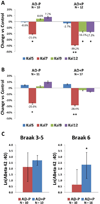Abnormal kalirin signaling in neuropsychiatric disorders
- PMID: 24334022
- PMCID: PMC3989394
- DOI: 10.1016/j.brainresbull.2013.12.006
Abnormal kalirin signaling in neuropsychiatric disorders
Abstract
Changes in dendritic spines structure and function play a critical role in a number of physiological processes, including synaptic transmission and plasticity, and are intimately linked to cognitive function. Alterations in dendritic spine morphogenesis occur in a number of neuropsychiatric disorders and likely underlie the cognitive and behavioral changes associated with these disorders. The neuronal guanine nucleotide exchange factor (GEF) kalirin is emerging as a key regulator of structural and functional plasticity at dendritic spines. Moreover, a series of recent studies have genetically and functionally linked kalirin signaling to several disorders, including schizophrenia and Alzheimer's disease. Kalirin signaling may thus represent a disease mechanism and provide a novel therapeutic target.
Keywords: Alzheimer's disease; Genetic; Glutamatergic; Mental disorder; Postmortem; Schizophrenia.
Copyright © 2013 Elsevier Inc. All rights reserved.
Figures




Similar articles
-
Scaffold protein X11α interacts with kalirin-7 in dendrites and recruits it to Golgi outposts.J Biol Chem. 2014 Dec 19;289(51):35517-29. doi: 10.1074/jbc.M114.587709. Epub 2014 Nov 5. J Biol Chem. 2014. PMID: 25378388 Free PMC article.
-
Kalirin signaling: implications for synaptic pathology.Mol Neurobiol. 2012 Feb;45(1):109-18. doi: 10.1007/s12035-011-8223-z. Epub 2011 Dec 23. Mol Neurobiol. 2012. PMID: 22194219 Free PMC article. Review.
-
Dendritic spine dynamics--a key role for kalirin-7.Trends Neurosci. 2008 Aug;31(8):419-27. doi: 10.1016/j.tins.2008.06.001. Epub 2008 Jul 1. Trends Neurosci. 2008. PMID: 18597863 Free PMC article. Review.
-
A Schizophrenia-Linked KALRN Coding Variant Alters Neuron Morphology, Protein Function, and Transcript Stability.Biol Psychiatry. 2018 Mar 15;83(6):499-508. doi: 10.1016/j.biopsych.2017.10.024. Epub 2017 Nov 7. Biol Psychiatry. 2018. PMID: 29241584 Free PMC article.
-
KALRN: A central regulator of synaptic function and synaptopathies.Gene. 2021 Feb 5;768:145306. doi: 10.1016/j.gene.2020.145306. Epub 2020 Nov 13. Gene. 2021. PMID: 33189799 Free PMC article. Review.
Cited by
-
Mouse and Human Genetic Analyses Associate Kalirin with Ventral Striatal Activation during Impulsivity and with Alcohol Misuse.Front Genet. 2016 Apr 7;7:52. doi: 10.3389/fgene.2016.00052. eCollection 2016. Front Genet. 2016. PMID: 27092175 Free PMC article.
-
A Novel Long Non-coding RNA, durga Modulates Dendrite Density and Expression of kalirin in Zebrafish.Front Mol Neurosci. 2017 Apr 10;10:95. doi: 10.3389/fnmol.2017.00095. eCollection 2017. Front Mol Neurosci. 2017. PMID: 28442991 Free PMC article.
-
Scaffold protein X11α interacts with kalirin-7 in dendrites and recruits it to Golgi outposts.J Biol Chem. 2014 Dec 19;289(51):35517-29. doi: 10.1074/jbc.M114.587709. Epub 2014 Nov 5. J Biol Chem. 2014. PMID: 25378388 Free PMC article.
-
Are Methylation Patterns in the KALRN Gene Associated with Cognitive and Depressive Symptoms? Findings from the Moli-sani Cohort.Int J Mol Sci. 2024 Sep 25;25(19):10317. doi: 10.3390/ijms251910317. Int J Mol Sci. 2024. PMID: 39408648 Free PMC article.
-
Regulating Rac in the nervous system: molecular function and disease implication of Rac GEFs and GAPs.Biomed Res Int. 2015;2015:632450. doi: 10.1155/2015/632450. Epub 2015 Mar 24. Biomed Res Int. 2015. PMID: 25879033 Free PMC article. Review.
References
-
- Alvarez VA, Sabatini BL. Anatomical and physiological plasticity of dendritic spines. Annu Rev Neurosci. 2007;30:79–97. - PubMed
-
- Amano M, Kaneko T, Maeda A, Nakayama M, Ito M, Yamauchi T, Goto H, Fukata Y, Oshiro N, Shinohara A, Iwamatsu A, Kaibuchi K. Identification of Tau and MAP2 as novel substrates of Rho-kinase and myosin phosphatase. J Neurochem. 2003;87:780–790. - PubMed
-
- Arendt T. Synaptic degeneration in Alzheimer's disease. Acta Neuropathol. 2009;118:167–179. - PubMed
-
- Bagni C, Greenough WT. From mRNP trafficking to spine dysmorphogenesis: the roots of fragile X syndrome. Nat Rev Neurosci. 2005;6:376–387. - PubMed
-
- Baloyannis SJ, Costa V, Mauroudis I, Psaroulis D, Manolides SL, Manolides LS. Dendritic and spinal pathology in the acoustic cortex in Alzheimer's disease: morphological and morphometric estimation by Golgi technique and electron microscopy. Acta Otolaryngol. 2007;127:351–354. - PubMed
Publication types
MeSH terms
Substances
Grants and funding
LinkOut - more resources
Full Text Sources
Other Literature Sources
Medical

